
How to Use ESP-WROOM-32 (Breadboard): Examples, Pinouts, and Specs
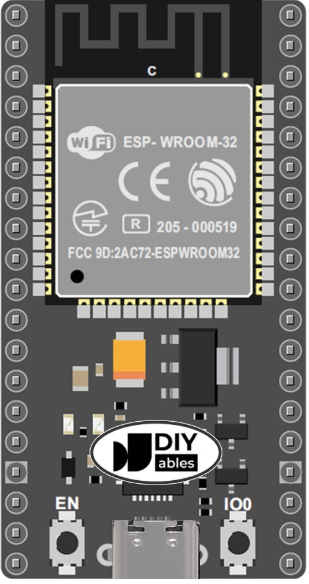
 Design with ESP-WROOM-32 (Breadboard) in Cirkit Designer
Design with ESP-WROOM-32 (Breadboard) in Cirkit DesignerIntroduction
The ESP-WROOM-32 is a versatile Wi-Fi and Bluetooth module developed by Espressif Systems. It is based on the powerful ESP32 chip, which integrates a dual-core processor, wireless connectivity, and a variety of peripherals. The breadboard-friendly design of the ESP-WROOM-32 makes it an excellent choice for prototyping and integrating into Internet of Things (IoT) projects.
Explore Projects Built with ESP-WROOM-32 (Breadboard)
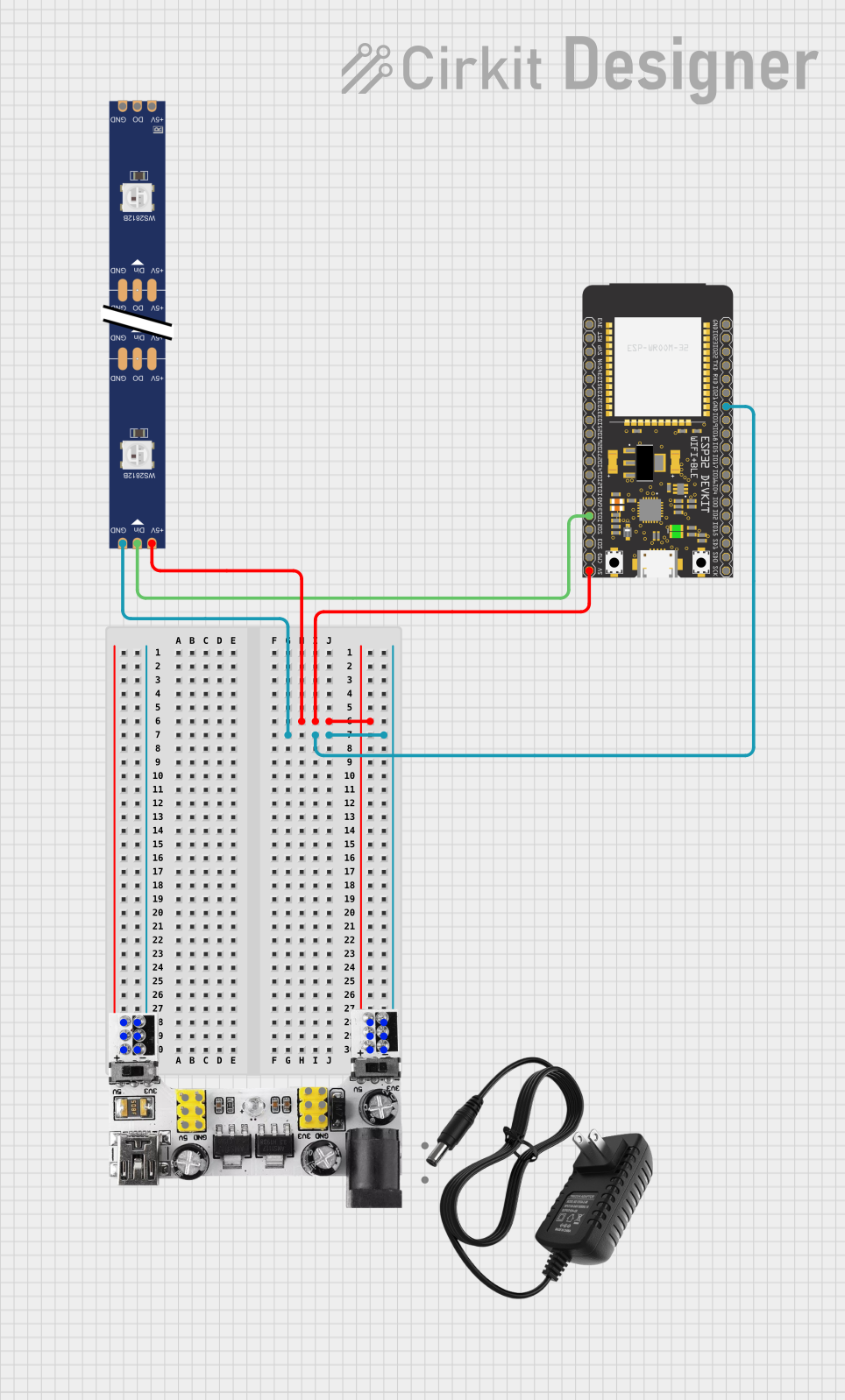
 Open Project in Cirkit Designer
Open Project in Cirkit Designer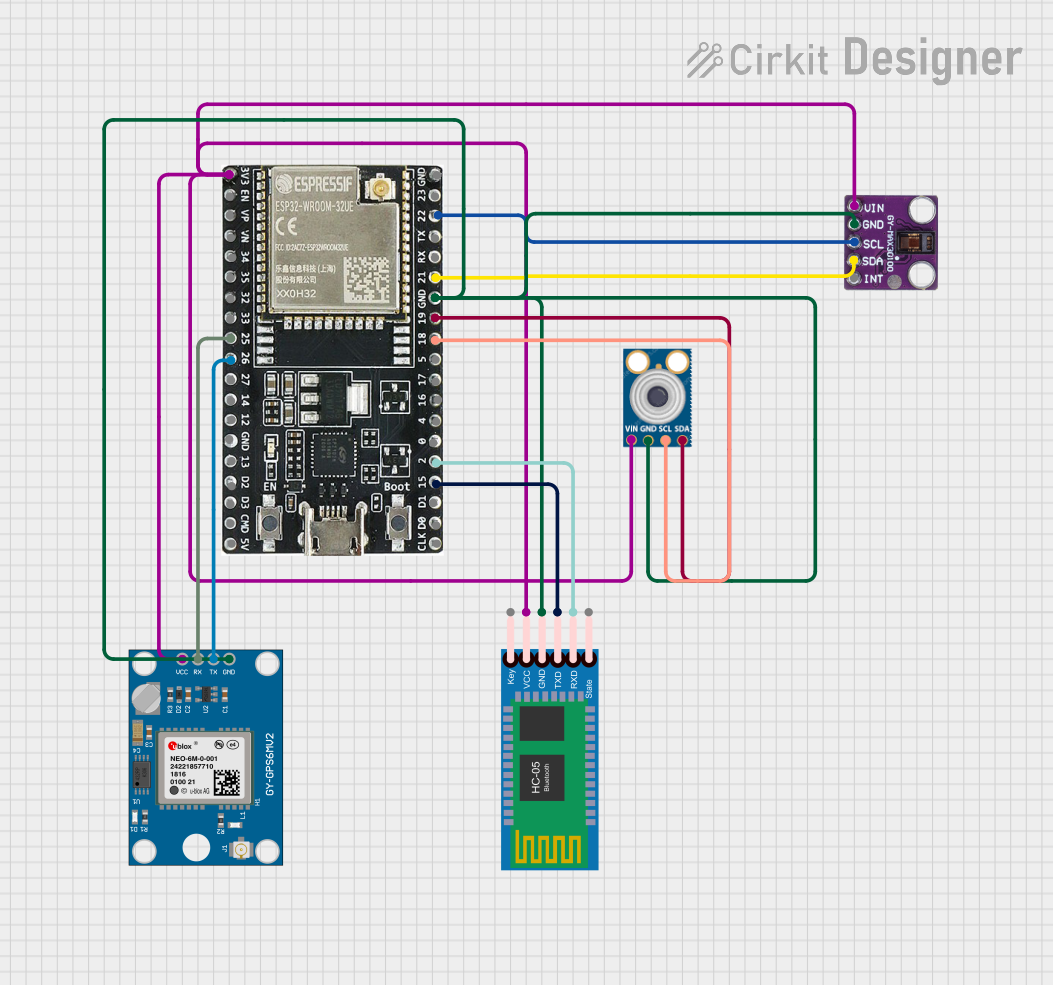
 Open Project in Cirkit Designer
Open Project in Cirkit Designer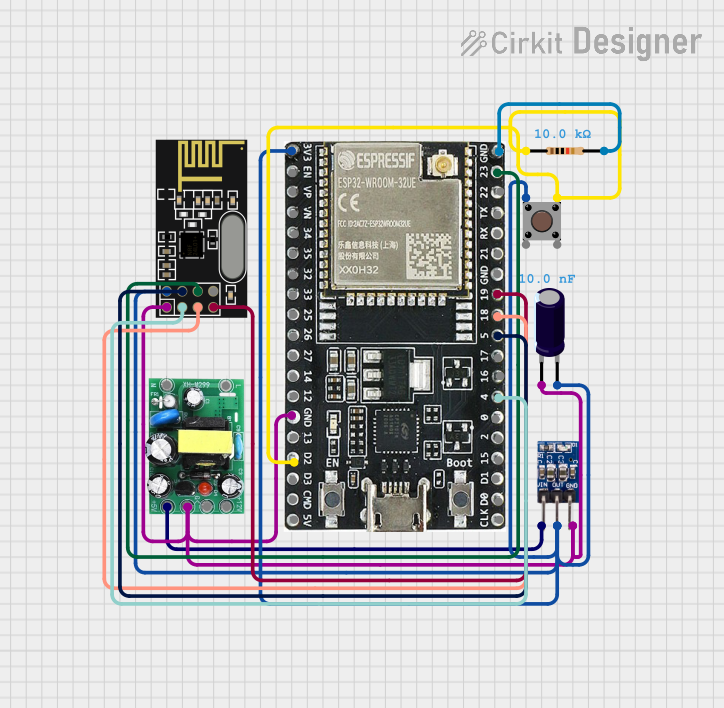
 Open Project in Cirkit Designer
Open Project in Cirkit Designer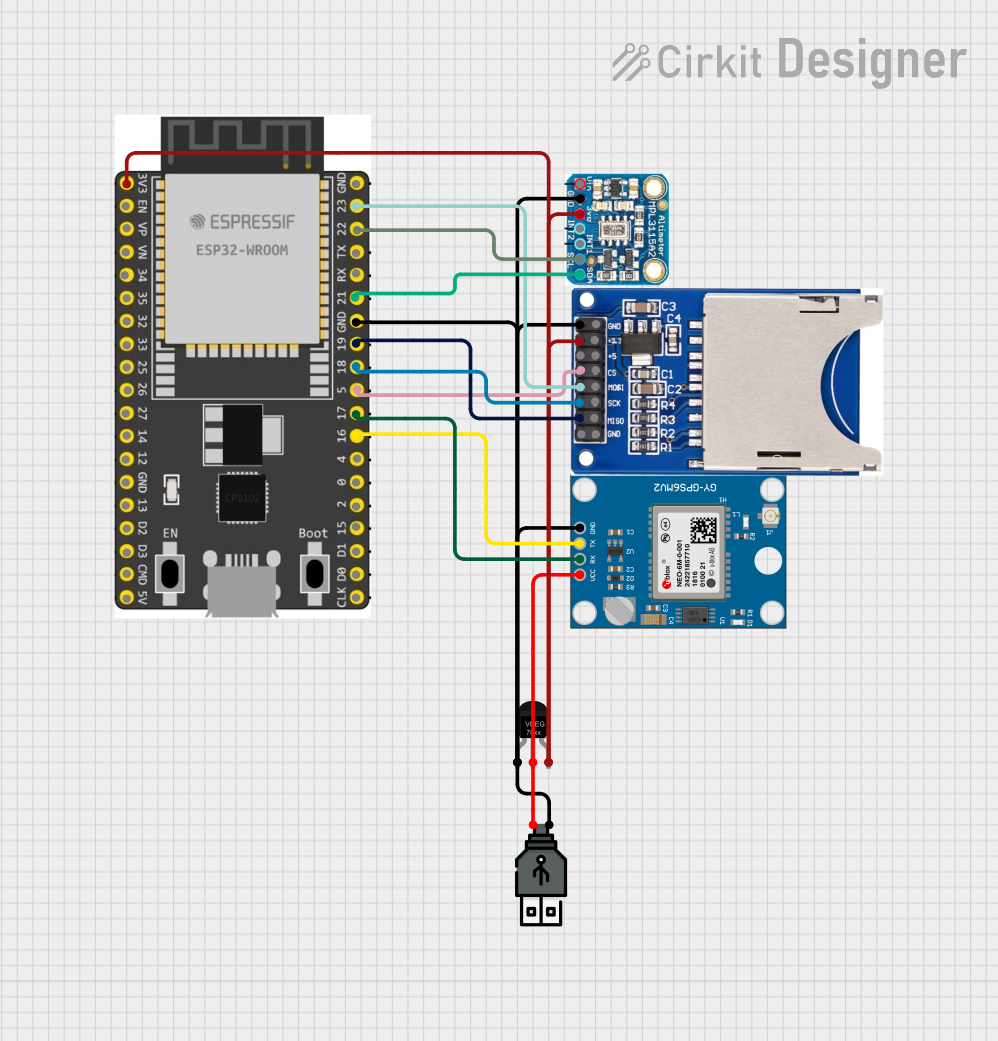
 Open Project in Cirkit Designer
Open Project in Cirkit DesignerExplore Projects Built with ESP-WROOM-32 (Breadboard)

 Open Project in Cirkit Designer
Open Project in Cirkit Designer
 Open Project in Cirkit Designer
Open Project in Cirkit Designer
 Open Project in Cirkit Designer
Open Project in Cirkit Designer
 Open Project in Cirkit Designer
Open Project in Cirkit DesignerCommon Applications and Use Cases
- IoT devices and smart home automation
- Wireless sensor networks
- Wearable electronics
- Industrial automation
- Robotics and drones
- Real-time data monitoring and logging
Technical Specifications
The ESP-WROOM-32 module is packed with features that make it suitable for a wide range of applications. Below are its key technical specifications:
| Parameter | Specification |
|---|---|
| Microcontroller | ESP32 (dual-core Xtensa® 32-bit LX6 processor) |
| Clock Speed | Up to 240 MHz |
| Flash Memory | 4 MB (default) |
| SRAM | 520 KB |
| Wireless Connectivity | Wi-Fi 802.11 b/g/n (2.4 GHz), Bluetooth v4.2 BR/EDR and BLE |
| Operating Voltage | 3.3 V |
| Input Voltage Range | 3.0 V to 3.6 V |
| GPIO Pins | 34 (multiplexed with other functions) |
| ADC Channels | 18 (12-bit resolution) |
| DAC Channels | 2 (8-bit resolution) |
| Communication Interfaces | UART, SPI, I2C, I2S, CAN, PWM |
| Power Consumption | Ultra-low power consumption in deep sleep mode (~10 µA) |
| Dimensions | 25.5 mm x 18 mm |
| Operating Temperature | -40°C to +85°C |
Pin Configuration and Descriptions
The ESP-WROOM-32 module has a total of 38 pins. Below is a table describing the most commonly used pins:
| Pin Name | Pin Number | Function |
|---|---|---|
| GND | Multiple | Ground |
| 3V3 | 1 | 3.3 V power supply |
| EN | 3 | Enable pin (active high, resets the chip when pulled low) |
| GPIO0 | 25 | Used for boot mode selection (must be pulled low for flashing) |
| GPIO2 | 26 | General-purpose I/O pin |
| GPIO16 | 8 | General-purpose I/O pin |
| GPIO17 | 9 | General-purpose I/O pin |
| TXD0 | 21 | UART0 Transmit |
| RXD0 | 22 | UART0 Receive |
| ADC1_CH0 | 36 | Analog-to-Digital Converter channel 0 |
| DAC1 | 25 | Digital-to-Analog Converter channel 1 |
| IO34 | 34 | Input-only GPIO |
Note: Some pins are multiplexed with other functions, such as ADC, DAC, or touch sensing. Refer to the ESP32 datasheet for detailed pin mappings.
Usage Instructions
How to Use the ESP-WROOM-32 in a Circuit
- Powering the Module:
- Connect the 3V3 pin to a 3.3 V power source.
- Ensure the power supply can provide sufficient current (at least 500 mA) for stable operation.
- Connecting to a Breadboard:
- Insert the module into a breadboard. The breadboard-friendly design ensures easy prototyping.
- Programming the Module:
- Use a USB-to-Serial adapter (e.g., FTDI or CP2102) to connect the module to your computer.
- Connect the TXD0 pin to the RX pin of the adapter and the RXD0 pin to the TX pin of the adapter.
- Pull the GPIO0 pin low to enter flashing mode.
- Flashing Firmware:
- Use the Espressif ESP-IDF or the Arduino IDE to upload code to the module.
- Select the appropriate board (e.g., "ESP32 Dev Module") in the IDE.
Important Considerations and Best Practices
- Voltage Levels: The ESP-WROOM-32 operates at 3.3 V. Avoid applying 5 V to any GPIO pin to prevent damage.
- Boot Mode: Ensure the GPIO0 pin is pulled low during flashing and released afterward.
- Antenna Placement: Avoid placing metal objects near the onboard antenna to ensure optimal wireless performance.
- Power Supply: Use a stable power source to prevent unexpected resets or instability.
Example: Connecting to an Arduino UNO
The ESP-WROOM-32 can communicate with an Arduino UNO via UART. Below is an example of how to send data from the Arduino to the ESP-WROOM-32:
Arduino Code Example
// Example: Sending data from Arduino UNO to ESP-WROOM-32 via UART
void setup() {
Serial.begin(9600); // Initialize Arduino's serial communication
Serial.println("Arduino is ready to communicate with ESP-WROOM-32");
}
void loop() {
// Send a message to the ESP-WROOM-32 every 2 seconds
Serial.println("Hello from Arduino!");
delay(2000);
}
ESP-WROOM-32 Code Example (Arduino IDE)
// Example: Receiving data from Arduino UNO on ESP-WROOM-32
void setup() {
Serial.begin(9600); // Initialize ESP-WROOM-32's serial communication
Serial.println("ESP-WROOM-32 is ready to receive data");
}
void loop() {
// Check if data is available from Arduino
if (Serial.available()) {
String data = Serial.readString(); // Read the incoming data
Serial.print("Received: ");
Serial.println(data); // Print the received data
}
}
Note: Ensure the Arduino's TX pin is connected to the ESP-WROOM-32's RXD0 pin, and the RX pin is connected to the TXD0 pin.
Troubleshooting and FAQs
Common Issues and Solutions
Module Not Responding:
- Ensure the module is powered correctly (3.3 V, sufficient current).
- Check the connections to the USB-to-Serial adapter.
- Verify that the GPIO0 pin is pulled low during flashing.
Wi-Fi Connection Fails:
- Ensure the correct SSID and password are used in the code.
- Check for interference or weak signal strength near the module.
Random Resets:
- Verify the power supply is stable and capable of providing at least 500 mA.
- Add a capacitor (e.g., 10 µF) across the power supply pins to filter noise.
Serial Communication Issues:
- Ensure the baud rate in the code matches the baud rate of the Serial Monitor.
- Double-check the TX and RX connections between the ESP-WROOM-32 and the other device.
FAQs
Q: Can the ESP-WROOM-32 operate on 5 V?
A: No, the module operates at 3.3 V. Use a level shifter if interfacing with 5 V devices.
Q: How do I reset the module?
A: Pull the EN pin low momentarily to reset the module.
Q: Can I use the ESP-WROOM-32 for Bluetooth communication?
A: Yes, the module supports Bluetooth Classic and BLE (Bluetooth Low Energy).
Q: What is the maximum range of the Wi-Fi connection?
A: The range depends on the environment but typically extends up to 100 meters in open space.
For more detailed information, refer to the official Espressif ESP-WROOM-32 datasheet.